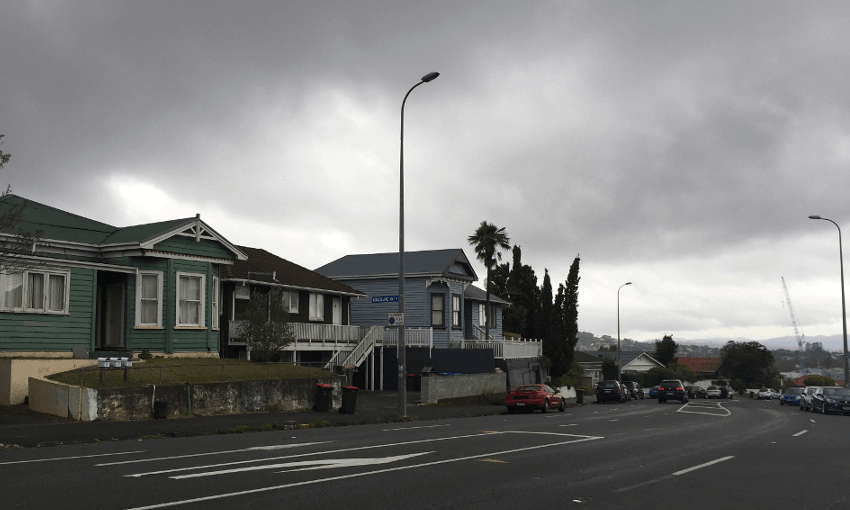Elle Hunt recalls her days renting in New Zealand as a time of suffering and survival. But don’t we deserve better?
A case often made in favour of buying a house (as though it were something that you could simply be persuaded into) is that renting is “just throwing money down the drain”. Firstly, that’s patently not true: you get somewhere to live in exchange. Secondly, throwing money down the drain sounds relatively painless compared to some of the houses I inhabited in Wellington.
When I look back at my rental history, it feels like something I’ve survived. The three-bed in Aro Valley with the distinctly listing floor so you could sit on a skateboard on one side of the living room and, entirely motionless, roll your way to the other. The enormous room on The Terrace with the bay window, great on the fabled Wellington “good days”, but drafty and impossible to heat for the other 345. The converted warehouse with the mezzanine room without a door, where I awoke before dawn one day to find my flatmate drunkenly showing it to her friend (yes, that wasn’t the landlord’s fault, but a door wouldn’t have hurt).
In every one of them, there was the creeping black mould continually needing to be beaten into retreat – one nostril was out of action for the length of my lease in Aro Valley. Add to that the necessity of sucking up to the property manager just to get a look-in for a house the SPCA wouldn’t knowingly rehome an animal in, and having to pay through the nose for it (the unblocked nostril, anyway). At the very least, you can say it’s character building.
In fact when I was a student – and even in my first years of working, given the competitiveness of Wellington’s rental market – I remember renting often being talked about in exactly those terms, as though housing was something you endured, and that could kill you or make you stronger. Among students, it was almost competitive: whose flat had the most mould? Who had the worst associated breathing difficulties? (“You call that black lung? THIS is black lung.”)
In that ‘can’t complain’ Kiwi way, just expressing a desire for more comfortable housing seemed to be construed as an admission of weakness or vulnerability. The truly hardcore lived in Dunedin. I remember hearing stories of Otago University students who, in winter, would not only go without heating but take their food out of the refrigerator to save on power.
Even in Wellington, when you were confronted by crowds outside house viewings like it was a new iPhone and not waterlogged weatherboard, there was a sense that you’d be lucky to get anything no matter how questionably inhabitable. And you were truly blessed if it had a heat pump.
That was how slim the pickings were for students and professionals, who could at least count on some steady income for housing, even if it did take up a disproportionate part of it. I can’t imagine the standard of living endured by those unable to afford even the overpriced, poor-quality average.
I was reminded, with zero nostalgia, of my former flats this week by the government’s new Healthy Homes standards becoming law on Monday. Private landlords now have just over two years to ensure their rental properties meet standards for heating, insulation and ventilation, potentially improving conditions for the more than 600,000 New Zealanders who live in rented homes. I can’t help but wonder what extreme makeover my old landlord on The Terrace has got in the works. The winter I spent in his house, I truly learned what it was to be cold, and secretly fostered kittens just for the extra body heat.
Here in London, though, I’ve gone soft. I pay a truly obscene amount on rent (especially when I convert to NZD), but in every room, there’s a radiator. The windows are double-glazed. I can wear just a T-shirt inside my flat, even during the months when I have to pack on six layers to step outside.
It’s been an education in what’s possible to expect of a property you don’t own. But in New Zealand, it will take a culture shift among landlords, and Healthy Homes might be what it takes to force it. Researchers from the University of Otago carried out rental warrant-of-fitness checks on 83 homes in Taranaki, 92% of which failed. Yet their study, published in the Australian and New Zealand Journal of Public Health in April, showed that even when informed of their property’s shortcomings, many owners did not feel the need to do anything about them.
One of the barriers was a lack of knowledge about the home’s defects, or “believing the property [was] in better condition than it objectively is”. That’s easy enough to do – when you don’t live in it. The paper’s authors suggested that tougher laws might be enough to force the necessary improvements, and that’s what this Healthy Homes legislation sets out to do.
It’s certainly an ambitious plan – I can’t imagine that my living room on The Terrace would ever reach the mandated 18 degrees Celsius no matter how many kittens – and it may, as detractors warn, push up rent even further. But it will, one hopes, at least train landlords’ minds on the concept that warm, dry homes are for everyone – not just for owners.
